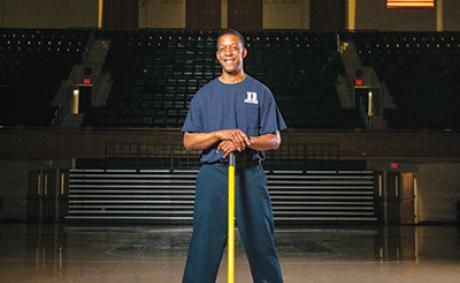To get weather and climate forecasts right, we need to think much smaller.
Think of it in terms of space. Many climate models break the Earth into a grid, with each square 100 km, or 62-ish miles, a side. Smaller storms are averaged out. The small-scale landscape features that drive convection, or cloud formation, aren’t considered.
But, without taking actual landscape data and smaller clouds into account, forecasts and climate models won’t be accurate. They’ll think too big and miss too much.
“What seems like a small issue is one of the biggest knobs you could tune as far as energy budgets go in a climate model,” says Jason Scot Simon, a post-doctoral associate with Duke‛s Pratt School of Engineering.
Simon joined Pratt civil and environmental engineering (CEE) professors Nate Chaney and Andy Bragg to zero in on exactly that: the macro-sized weather effects of micro-sized landscape features. Where previous studies used invented terrain, this team used actual landscape features and weather data gathered at an Oklahoma research station. They found that, even on a scale as little as 30 meters, or about 100 feet, small landscape differences have enormous impacts on cloud formation and weather. Where there’s a farm by an urban area, a lake by warm ground or even wet ground by dry ground, convection forms clouds. It’s the water cycle, sure, but it has to be considered on the neighborhood level or smaller to catch important drivers of cloud and storm formation.
It’s a more limited scale than can be realistically included in current models, not at current processing speeds at least. Some findings — such as why summer afternoon thunderstorms follow the paths they do — point to what could be gained with realistic land surface patterns worked into our models. It’s the difference between getting your picnic on and getting your picnic rained on.
“Scattered thunderstorms breed scattered thunderstorms,” says Chaney.
The team studied a specific kind of Oklahoma summer day. It dawns clear and blue. Later, white popcorn clouds sail overhead. The afternoon sky darkens and rumbles, and small scattered thunderheads surge through.
While Chaney studies landscape differences, Simon and Bragg specialize in fluid mechanics and turbulence, so their portion of the research happens in the clouds themselves. Between them, they found that the wet ground an afternoon thunderstorm leaves behind is enough to spawn the next day’s thunderstorm when it evaporates. One day’s storms beget the next day’s storms beget the next day’s storms, and all because of a small-scale difference on the land itself.
"The difference between getting your picnic on and getting your picnic rained on."
“Climate models are very bad at the afternoon thunderstorm cycle,” says Simon. “The timing of them is off. The magnitude of them is off. This is one of the biggest known issues.”
Bragg and Simon are part of Chaney’s CLASP team, which stands for Coupling of Land and Atmospheric Subgrid Parameterizations. It’s a U.S. government-funded project drawing experts from Duke, NOAA, NASA, the U.S. Department of Energy, Princeton and George Mason University. CLASP itself is part of a larger network of Climate Process Teams (CPTs), initiated by the U.S. Climate Variability and Predictability Program to improve climate models and their ability to predict the climate decades in the future.
Simon works as a clouds guy, though to him convection is simply an intriguing physics problem. Weather didn’t capture his attention growing up, but interesting math on computers did. His coursework at North Carolina State University led him to water reservoir-related computation, which he loved. From there, he progressed through flood modeling and into atmospheric modeling. The electricity and magnetism corners of engineering aren’t intuitive to Simon, but water makes sense.
“Compared to electron spinning — one you can imagine, and one is a lot harder to imagine,” Simon explains. “It’s funny, because now I model air, which you literally can’t see.”
Chaney is the opposite — a total cloud-gazer. His story spills out, fully formed, as if he’s been dying to tell it: A young Chaney was obsessed with snow, and he checked weather reports far more frequently than your average 10-year-old. That, coupled with frequent family backpacking trips — the Wind River mountains in Wyoming and the John Muir Trail in California; the Alps and Pyrenees — also helped to bring the other half of Chaney’s specialty into focus. As a child, he loved the interplay of landscapes — the streams, the meadows, the forests, the mountains themselves.
Bragg came to advanced fluid mechanics from a working-class English background. Growing up in South Shields, near Newcastle, nobody instilled a love of learning. Indeed, Bragg was the first in his family to go to a university. Then he stumbled into university where he found many of the courses incredibly boring. But, those focused on math and physics awoke something in him. By the time Bragg was working on his doctorate he was playing in the sandbox of theoretical fluid dynamics and turbulence, which continue to thrill him.
“I say with a lot of seriousness that I never really used my brain until I was 22,” he says, soft-spoken and a little wry.
As Bragg knows, there are many more problems in turbulence left to be attacked. The afternoon summer thunderstorm is simple compared to the severe thunderstorm, a complex monster that’s still beyond us. It’s not next in line, but farther down the line for study by teams like this.
Climate is a chaotic system, and errors compound errors, Chaney says. Yet he, Simon and Bragg aim to remove at least a little chaos from models that are trying to predict climate up to 50 years in the future.
Their study communicates to the broader climate modeling community how to think about and model small landscape patterns’ impact on the atmosphere. The benefits of doing so — of thinking small — can be felt in large-scale weather prediction five or six days out, or climate models four or five decades out.
“If the atmosphere is so sensitive to these spatial patterns on small scales, if we don’t represent that in climate models, our climate models are not going to be able to get convection right,” says Chaney. “We’re going to have problems with weather prediction in the summer.”
And fewer problems means fewer afternoon storms sneaking up on us, just in general — a big victory for attention to detail.





